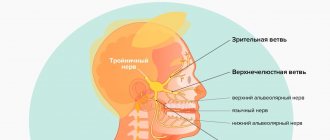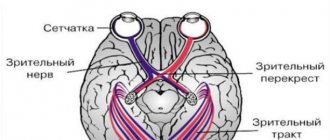Everyone is familiar with the feeling of sharp pain as a result of an elbow strike. It’s as if an electric current shoots through the arm from the elbow joint to the little finger, sometimes radiating up the shoulder. This occurs due to contusion of the ulnar nerve. Compression of the nerve at the elbow joint is called cubital tunnel syndrome or cubital tunnel syndrome.
The disease is the second most common among carpal tunnel syndromes, second only to carpal tunnel syndrome.
Anatomy of the ulnar nerve and cubital tunnel
The ulnar nerve originates in the cervical plexus, being one of the three main nerves of the upper limb. It runs along the inner surface of the shoulder, then lies in the canal formed by the olecranon process, the internal epicondyle and the ligament that connects these two bone formations, forming a rather narrow cubital canal.
Next, the nerve passes through the intermuscular space of the forearm, flowing into another channel, this time on the wrist. This canal is called the Guyon Canal. It is at the level of this canal that the ulnar nerve begins to divide into 3, sometimes 4 branches, ending with the sensory branches of the 5th and inner half of the 4th fingers, as well as the motor branches of the 3-4-5 lumbrical muscles of the hand.
Causes of cubital tunnel syndrome
The cause of this particular disease is compression of the nerve in the cubital canal. In this article we do not discuss nerve injury.
There are several causes of cubital tunnel syndrome:
- repeated trauma to the ligaments and bone structures of the elbow joint that form the canal,
- intense sports,
- arthritis, arthrosis of the elbow joint
- synovitis of the elbow joint or hemarthrosis
- repeated monotonous activities,
- consequences of fractures can also be the causes of the syndrome.
For drivers, the disease can be caused by the habit of placing their elbow on the window opening of the car door. When symptoms appear, this habit will have to be eradicated.
At the computer, you should pay attention to the position of your hand when working on the keyboard and mouse. When doing this type of work, the forearm should rest completely on the tabletop. You can put something soft under the sore elbow.
Compression of the ulnar nerve in the canal can be caused by inflammatory processes not only in the nerve tissue, but also in the soft tissue component of the cubital canal wall. For example, with medial epicondylitis, inflammation in the projection of the internal epicondyle can cause swelling and compression of the nerve. Failure to consult a doctor in a timely manner and delays in starting treatment can lead to organic damage to the wall and the process becoming chronic. As a result of the thickening of the nerve sheath, the transmission of nerve impulses may become difficult, leading to loss of sensation and motor function in some muscles of the hand and forearm.
Carpal tunnel syndrome - symptoms and treatment
The initial method of treatment for patients with carpal tunnel syndrome can be a change in daily activity, the elimination of harmful occupational factors, and ergonomic organization of the workplace when working at a computer - the use of special mice, rugs and keyboards [23].
Another method that has been shown to be effective and safe is wrist orthosis, in which the wrist joint is placed in a neutral position. This minimizes the negative impact on the median nerve from the surrounding structures [5].
Many other techniques can be used in complex treatment: manual therapy, physiotherapy, kinesiotaping, but data on their effectiveness are contradictory [5].
Drug treatment is also used as therapy for patients with carpal tunnel syndrome. It is aimed at reducing inflammation and swelling in the carpal tunnel area, which leads to relief of symptoms.
A fairly large number of drugs are used in clinical practice, but for most drugs the effect is short-term and insignificant. An exception is corticosteroid drugs, especially when applied locally in the form of drug paraneural blockades (injection of an anesthetic into the space near the kidneys) [5].
There is also a wide variety of surgical treatment methods, which differ only in the options for surgical access [24]. However, the basis of any intervention is the dissection of the transverse ligament of the carpal tunnel and the release of the median nerve from compression (squeezing) by surrounding tissues.
The choice of surgery and treatment technique depends on many factors:
- degree of compression of the median nerve;
- presence of concomitant diseases;
- features of the anatomy of the carpal tunnel;
- surgeon preferences [25].
Surgery is a radical treatment method that normalizes the pressure inside the carpal tunnel. The effect of surgical treatment is superior to all currently existing conservative methods. In addition, people can return to their professional activities within two weeks after the operation. However, despite the widespread prevalence of carpal tunnel syndrome, there is still no uniform tactic for determining indications for surgery. Various authors offer their own criteria that allow selecting patients for surgical treatment, and in each case the decision is made individually [2][5].
Despite the variety of methods, there is no single approach to treating patients with carpal tunnel syndrome.
One point of view is that surgical treatment should be used only as a last resort: when conservative treatment is ineffective and in the presence of severe symptoms in the form of weakness and muscle wasting [26].
There is also an opinion that despite the wide variety of conservative treatment methods, their effectiveness is extremely low, so the achieved treatment result is short-lived. In this regard, it is not recommended to delay surgical intervention, since it is the most effective method of treatment [2][5].
Signs and symptoms of cubital tunnel syndrome
Symptoms of cubital tunnel syndrome include each of the following:
It is not necessary to have all the signs.
- Stiffness, loss of sensation, or significant dull or sharp pain in the ulnar part of the hand, 4th and 5th fingers.
- Pain and weakness when attempting to grasp an object with a brush.
- Discomfort in the elbow area.
Such symptoms indicate ischemia (lack of blood supply) of the nervous tissue. These symptoms are most pronounced in the morning, after the hand has been resting overnight. After some time, when the patient performs a certain amount of movements, the pain and numbness slightly recedes.
The dangers of self-medication and complications of carpal tunnel syndrome
If you have pain in your hand, in the wrist area, but you delay treatment, you are putting yourself at risk. The pain, which will bother you both day and night, will significantly reduce your performance and quality of life. If the syndrome is left untreated, the pinched nerve progresses. In this case, metabolic processes are disrupted, swelling and blood stagnation appear in the hands. In the future, the hand may become deformed. Painful sensations intensify and lead to insomnia, irritability, and neuroses. Don’t put yourself in danger – trust the treatment of pain in your hands and arms to professionals.
Diagnosis of cubital tunnel syndrome
When examining the elbow joint by a doctor, the patient may notice a significant increase in pain. A painful examination is necessary for a specialist to make an accurate diagnosis:
- If the nerve is compressed in the canal, there will be a positive Tinnel's sign, which is manifested by the sensation of a current shooting through the nerve into the little and ring fingers when the doctor taps with a neurological hammer - although this can happen when the nerve is without pathology, with a strong blow.
- The doctor will check to see if the nerve slips out of the canal when the patient bends the arm at the elbow.
- Tests sensitivity and strength in the hand and fingers.
If the doctor has doubts about the causes of cubital tunnel syndrome, the patient may be recommended to undergo additional examinations, such as MRI, ENMG, and radiography.
Radiography. Based on radiographs, it is possible to determine bone exostoses in the projection of the canal, which compress the nerve. But most of the causes of compression of the ulnar nerve cannot be seen on x-ray, since they are of soft tissue etiopathogenesis.
Electroneuromyography (ENMG). This study makes it possible to determine how well the impulses are transmitted along the nerve and to determine at what level and how much the nerve is compressed.
During nerve conduction testing, the nerve is stimulated proximally and the time required to conduct the impulse is measured and compared with normal values.
Cubital tunnel syndrome – treatment at the Surgery Center
Ulnar nerve tunnel syndrome can be successfully treated with timely referral to specialists. The Surgery Center offers a full range of services necessary for the diagnosis and successful treatment of the disease.
Why patients choose us:
- Surgeons with more than 8 years of experience.
- We specialize in hand surgery.
- Painless surgery without discomfort.
- There are no hidden fees - the price already includes examination, diagnosis, surgery and subsequent hospital care.
- Convenient work schedule.
- Modern equipment.
- Full support after surgery, including communication with the surgeon or a specialized specialist.
- Possibility of cash and non-cash payments.
Patients of our clinic receive qualified medical care and a comfortable stay within the walls of the center. We will help you regain your health! You can sign up for a consultation by ordering a call back on the website.
Treatment of cubital tunnel syndrome
The vast majority of such cases of the disease require non-surgical treatment. Non-surgical treatment options for cubital tunnel syndrome include:
- load reduction,
- temporary refusal of intense training,
- taking anti-inflammatory non-hormonal drugs.
Good remedies for treating cubital tunnel syndrome are anti-inflammatory non-steroidal ointments, taking vitamins and the patient undergoing a course of physiotherapy.
Surgical treatment of cubital tunnel syndrome is prescribed if therapeutic methods have not produced results after 12 weeks. During surgery, segments of the canal wall are removed from the patient and the tendon arches are cut. If it is impossible to expand the canal surgically, the nerve is completely removed from it, placing it between muscle tissue and fatty tissue.
Causes of pain in the hands
Median nerve tunnel syndrome has a number of causes and predisposing factors, namely:
- overweight;
- bad habits;
- changes in hormonal levels;
- thyroid diseases;
- dislocations, fractures, wrist sprains;
- long-term vibration effects;
- monotonous long movements of the hand and arms;
- diabetes, pregnancy, rheumatic diseases.
Carpal tunnel syndrome in children can develop with prolonged use of a computer mouse and keyboard.









